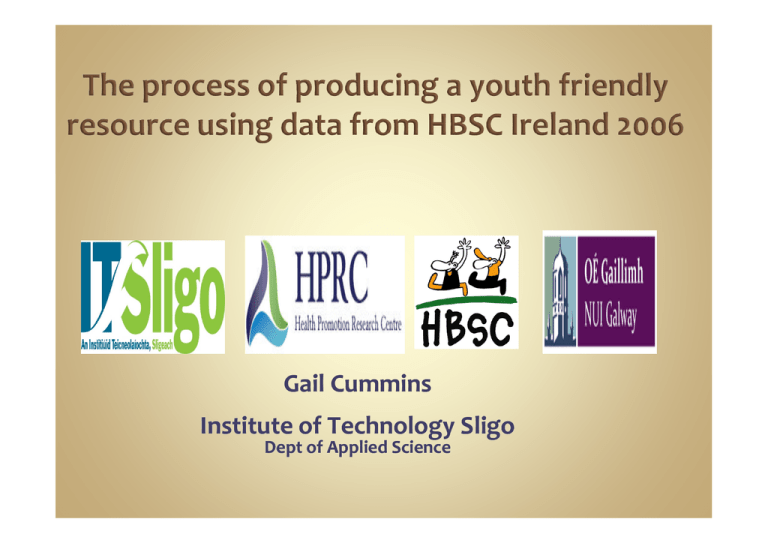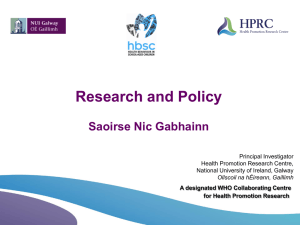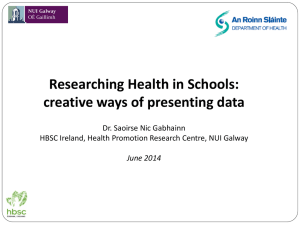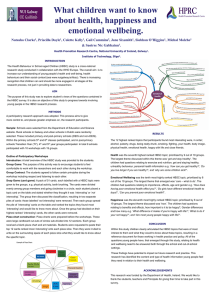Gail Gail Cummins Cummins Institute of Technology Sligo
advertisement

Gail Cummins Institute of Technology Sligo Dept of Applied Science HBSC The Health Behaviour in School-aged Children (HBSC) study is an international survey (www.nuigalway.ie/hbsc). Funded by the Department of Health and Children. The study aims to gain new insight into, and increase our understanding of young people's health and well-being, health behaviours and their social context. 3rd time study was conducted in Ireland School based study During the HBSC survey, children voluntarily give their time and information about themselves. Beyond the data collection phase children are not involved in the study. Other stakeholders are provided with various dissemination options. To explore young people’s ideas in relation to how the HBSC Ireland data can be disseminated as a youth friendly resource. Mixed gender schools Primary and post primary schools Rural & urban schools Deis & Non Deis schools * * Schools that are part of the Department of Education and Science’s Support Programme, under the Delivering Equality of Opportunity in Schools (DEIS) and schools that are not part of this programme (Non-Deis). Workshops Galway County (Rural) Dublin City (Urban) Primary School (DEIS) Primary School (NonDEIS) Post Primary School (DEIS) Post Primary School (NonDEIS) Primary School (DEIS) Primary School (NonDEIS) Post Primary School (DEIS) Post Primary School (NonDEIS) Number of Schools 1 1 1 1 1 2* 1 1 Number of Workshops 1 1 1 2 1 2 1 1 Number of Groups 1 2 2 4 2 4 2 2 1. HBSC Introduction 6. Brainstorm Session & Closing 2. Group Contract Workshop protocol 3. Ice – breaker Game 5. Pizza Chart Game 4.Snap Game 1. •Each group was given a pack containing 51 HBSC cards. 2. •Youngest person in the group was asked to deal the cards evenly among group. 3. •Person next to dealer was asked to lay down a card and say where they felt it was interesting or not. 4. •Entire group joined in discussion. Card then placed in interesting or non interesting pile. 5. •Each group asked to look through interesting pile and rank the topics they found most interesting. Liking Tooth School brushing Injuries 1. A pre prepared blank pizza chart was given out to each group. This chart was a large circle with 10 segments (resembling a pizza). 2. Students were asked to glue one of their highest ranked topic cards in each pizza segment. 3. Students were asked to write down in each segment what they would like to know about that specific topic. Brainstorm Session Using a large flipchart each group were asked to brainstorm the following question “How can we give you this information – what type of resource/format would you like?”. Highest Rank Interesting Topics - Snap Game Ranking Topic 1 Alcohol 2 Puberty 3 Drugs 4 Being really drunk 5 Smoking 1. 6. Alcohol Fighting 2. Puberty 3. Drugs 5. Smoking 4. Being really drunk 7. 12. Your health Close friends 8. Body Image 9. Physical Health 11. Happy with life 10. Emotional health 1. Alcohol Highest ranked HBSC topic among all the schools, 16 out of the 19 groups. 3 exceptions to this were all groups from non-deis schools; two were post primary (1 urban and rural) and a rural primary. The diagram illustrates preferred dissemination methods and resources that were specifically identified by the young people in order to disseminate HBSC information to them. 1. DVD 2. Presentations & talks 3. Books/Reports 4. Internet 5. Factsheets DVD was the most discussed resource with all schools mentioning it. Four general themes emerged from these DVD discussions and included: what they “want” if a DVD is developed, what they “don’t want” from a DVD resource, “advantages and disadvantages” of developing a DVD resource. HPRC Team in NUI, Galway Dr. Colette Kelly, Priscilla Doyle, Dr. Michal Molcho, Dr. Saoirse Nic Gabhainn, Dr. Jane Sixsmith Health Promotion Team, Institute of Technology, Sligo Margaret McLoone, Dr. Etain Kiely, Gail Cummins


